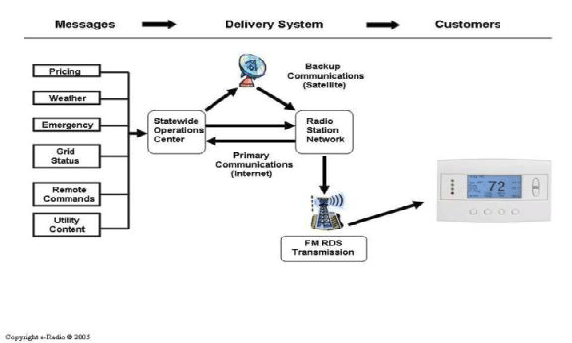How Will The Statewide System Work?
A preliminary operating schematic of a statewide network is provided below:


California continues to push forward with revisions to its Title 24 Building Energy Efficiency Standards that will mandate a programmable communicating thermostat (PCT) for all new residential buildings. PCT’s are thermostats that receive price or electric system reliability signals, and can be programmed by the customer to automatically reduce energy consumption through thermostat setpoint adjustments. This initiative will be effective beginning in 2009.
PCTs are part of California’s strategy to develop a statewide demand response system that can be used to encourage a more informed and empowered customer base. In time, such a system is expected to reduce system costs and prevent system disruptions. Other North American states and provinces are closely watching the California Title 24 initiative with interest in adopting similar programs.
The California Energy Commission (CEC) has proposed that all PCT’s will contain an embedded one-way FM-RDS radio communications module that can receive and decode messages. This communications system is intended as a low-cost statewide default messaging system that will precede but eventually co-exist with future home automation systems. To encourage interoperability, PCTs are also required to have expansion ports that will allow utilities and other service providers to add communications modules and establish links to other devices. Thermostat manufacturers are currently developing prototype PCT devices based on the California specifications, which include functionality for both pricing and load control programs. These devices may lead to a standardized US or global PCT.
The California Public Resource Code assigns the CEC with the responsibility of developing and maintaining standards for energy efficiency and load management. PCTs, a proposed addition to the 2008 Title 24 building standards, will enable new buildings with automated load management capabilities. The recently-released Title 24 revision proposal is currently in a 45-day comment period and has final adoption date of January 30, 2008.
The CEC is focusing on air-conditioning (AC) for many reasons. AC load control has long been considered a viable strategy for reducing peak demand because it is large and generally considered to be discretionary. AC is California’s largest peak load, so aggregate load drops can be significant - up to 30% of California peak load. However, since the full AC demand is made up of millions of individual loads, addressability in PCTs would allow for the isolation of very small and geographically focused loads. And for most homes and businesses, an increase of a few degrees would not significantly impact comfort or economics, particularly if it happens only during extreme emergencies (less than once per year).
The development of a low-cost, statewide PCT standard is expected to reduce the costs of future utility programs by integrating support for pricing, efficiency, and demand response programs into a single interoperable and expandable device. PCTs or analogous technologies are envisioned to support dynamic pricing, incentive programs and system reliability. The recently completed California Statewide Pricing Pilot demonstrated the effectiveness of PCTs in achieving these goals. In addition, the PCT can provide a new source of messaging capabilities from utility companies to their customers and another method to communicate during disaster or emergency periods.
Currently, the CEC envisions that the primary function of PCTs is to allow customers to save or earn money by participating in pricing or AC load control programs offered by their service providers. These automated actions can lower everyday peaks and initiate significant demand response when wholesale costs are high, helping to avoid emergencies. Should an emergency occur, the secondary function of a PCT network is to avoid rotating outages by quickly dropping geographically-targeted AC load.
A preliminary operating schematic of a statewide network is provided below:

California has devoted a sizable effort developing standards for a statewide PCT. A PCT reference design has been established that specifies features and requirements. The statewide PCT will contain typical programmable setback and display features, a non-removable FM-RDS communications module, a 24-volt power supply and the ability to randomize the load rebound to a programmed setpoint after an event.
The PCT will also contain a standard expansion port to allow the insertion of a utility-specific communications module to support utility demand response or home automation programs. In addition, the PCT will have addressability features to allow for targeted messaging to the substation level with a goal to address the individual PCT. The RDS communications module must also support encryption standards that are currently being developed to ensure a secure statewide network. Currently, several thermostat manufacturers have developed prototype Title 24 PCT devices.
California carefully considered several technologies for the communications method for a statewide network. A research team at UC Berkeley recommended the use of FM radio Radio Data System (RDS) to the CEC as the best communications solution for the Title 24 statewide network.
RDS leverages an existing FM radio infrastructure and a global communications standard that is widely used in the automotive industry. Other benefits of RDS include wide signal coverage that can effectively reach remote areas, strong building penetration, minimal message latency, addressability and encryption support and the reliability of 24x7x365 availability. RDS bandwidth and hardware costs are also lower as compared to other technologies.
In preparation for the enactment of revisions to the Title 24 standards in California, several technical initiatives and pilot programs are underway:
There are several technical and operational issues that need to be addressed before a PCT system can be become operational on a statewide basis.
California continues to take steps to mitigate statewide energy crisis conditions it has encountered over the past decade such as sharply rising energy prices and rolling blackouts. A statewide system to communicate with PCT’s is a building block strategy towards creating a more reliable supply of energy and allowing utility company energy efficiency programs to develop and flourish. These programs are also consistent with California’s priorities to be a world leader in energy efficiency and the reduction of greenhouse gas emissions.